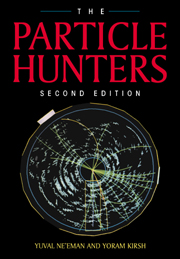Book contents
- Frontmatter
- Contents
- Preface to the first edition
- Preface to the second edition
- 1 The building blocks of the atom
- 2 Physical laws for small particles
- 3 The discoveries of the 1930s and 1940s
- 4 Particle accelerators — or from hunters to farmers
- 5 Strange particles
- 6 Basic forces and the classification of particles
- 7 Conservation laws
- 8 Short-lived particles
- 9 To the quarks — via the eightfold way
- 10 More quarks — or charm, truth and beauty
- 11 The Standard Model and beyond
- Appendix 1 Properties of semi-stable particles
- Appendix 2 The Greek alphabet
- Name index
- Subject index
8 - Short-lived particles
Published online by Cambridge University Press: 05 August 2012
- Frontmatter
- Contents
- Preface to the first edition
- Preface to the second edition
- 1 The building blocks of the atom
- 2 Physical laws for small particles
- 3 The discoveries of the 1930s and 1940s
- 4 Particle accelerators — or from hunters to farmers
- 5 Strange particles
- 6 Basic forces and the classification of particles
- 7 Conservation laws
- 8 Short-lived particles
- 9 To the quarks — via the eightfold way
- 10 More quarks — or charm, truth and beauty
- 11 The Standard Model and beyond
- Appendix 1 Properties of semi-stable particles
- Appendix 2 The Greek alphabet
- Name index
- Subject index
Summary
We can divide the brief history of research on elementary particles into a number of periods, among them times of bewilderment and confusion and others of astounding discoveries; periods characterized by feverish study concentrated on a single subject, and periods during which progress was made on many fronts. During the years between 1947, the year the first V-tracks were discovered, and 1953, when the ‘strangeness’ idea was first proposed, experimental efforts were concentrated on the study of strange particles. Towards the end of the 1950s and during the early 1960s interest turned towards a new type of extremely short-lived particles, which were termed resonances.
Extremely short-lived particles
The reader who has gained some insight into the various conservation laws, and has understood how certain particles — such as strange particles — manage to live so long, thanks to conservation laws which prohibit decay by strong interactions, may now ask: Can't energetic collision (between protons for instance) also produce particles which are not barred by any conservation law from decaying by the strong interaction? If such particles do exist, their life expectancy is of the order of only 10-23 seconds (the time required for the effect of the strong force to traverse a distance equal to the diameter of the particle).
- Type
- Chapter
- Information
- The Particle Hunters , pp. 180 - 194Publisher: Cambridge University PressPrint publication year: 1996



